*NURSING > TEST BANK > HESI Fundamentals, OVER 800 QUESTIONS WITH ACCURATE ANSWERS 12 Latest Versions Verified Ques (All)
HESI Fundamentals, OVER 800 QUESTIONS WITH ACCURATE ANSWERS 12 Latest Versions Verified Questions and Answers Best Document for Exam Preparation 100 % Satisfaction Guaranteed Complete and Latest Guide For HESI Fundamentals Exam 2021lOMoAR cPSD|4990434 HESI FUNDAMENTALS
Document Content and Description Below
HESI Fundamentals 12 Latest Versions Verified Questions and Answers Best Document for Exam Preparation 100 % Satisfaction Guaranteed Complete and Latest Guide For HESI Fundament... als Exam 2021lOMoAR cPSD|4990434 HESI FUNDAMENTALS 1. A policy requiring the removal of acrylic nails by all nursing personnel was implemented 6 months ago. Which assessment measure best determines if the intended outcome of the policy is being achieved. a. Number of staff induced injury b. Client satisfaction survey c. Health care-associated infection rate. d. Rate of needle-stick injuries by nurse. 2. The nurse is preparing to assist a newly admitted client with personal hygiene measures. The client...the client’s gag reflex. Which action should the nurse include? A. Offer smalls sips of water through a straw B. Place tongue blade on back half of tongue C. Use a penlight to observe back of oral cavity D. Auscultate breath sounds after client swallows 3. The nurse explains to an older adult male the procedure for collecting a 24-hour urine specimen for creatinine clearance. A. Assess the client for confusion and reteach the procedure B. Check the urine for color and texture C. Empty the urinal contents into the 24-hour collection container D. Discard the contents of the urinal 4. A 54-year-old male client and his wife were informed this morning that he has terminal cancer. Which nursing intervention is likely to be most A. Ask her how she would like to participate in the client’s care B. Provide the wife with information about hospice C. Encourage the wife to visit after painful treatments are completed D. Refer her to support group for family members of those dying of cancer 5. A client who has a body mass index (BMI) of 30 is requesting information on the initial approach to a weight loss plan. Which action should the nurse recommend? A. Plan low carbohydrate and high protein meals B. Engage in strenuous activity for an hourdaily C. Keep a record of food and drinks consumed daily D. Participated in a group exercise class 3 times a week 6. The nurse assesses a client who has a nasal cannula delivering oxygen at 2 L/min. To assess for skin damage related to the cannula, which areas should the nurse observe? A. Tops of the ear B. Bridge of the nose C. Around the nostrils D. Over the cheeks E. Across the forehead 7. The nurse observes an unlicensed assistive personnel (UAP) who is providing a total bed bath for a confused and lethargic client. The UAP is soaking the client’s foot in a basin of warm water placed on the bed. What action should the nurse take? a. Remove the basin of water from the client’s bed immediately b. Remind the UAP to dry between the client’s toes completely c. Advise the UAP that this procedure is damaging to the skin d. Add skin cream to the basin of water while the foot is soaking 8. The nurse in the emergency department observes a colleague viewing the electronic health record (EHR) of a client who holds an elected position in the community. The client is not a part of the colleague’s assignment. Which action should the nurseimplement? a. Communicate the colleague’s actions to the unit charge nurse b. Send an email to facility administration reporting the action c. Write an anonymous complaint to a professional website d. Post a comment about the action on a staff discussion board 9. At 0100 on a male client’s second postoperative night, the client states he is unstable to sleep and plans to read until feeling sleepy. What action should the nurse implement? a. Leave the room and close the door to the client’s room b. Assess the appearance of the client’s surgical dressing c. Bring the client a prescribed PRN sedative-hypnotic d. Discuss symptoms of sleep deprivation with the client 10. The nursing staff in the cardiovascular intensive care unit are creating a continuous quality improvement project on social media that addresses coronary artery disease (CAD). Which action should the nurse implement to protect client privacy? a. Remove identifying information of the clients who participated b. Recall that authored content may be legally discoverable c. Share material from credible, peer reviewed sources only d. Respect all copyright laws when adding website content 11. A male client with unstable angina needs a cardiac catheterization, so the healthcare provider explains the risks and benefits of the procedure, and then leaves to set up for the procedure. When the nurse presents the consent form for signature, the client hesitates and asks how the wires will keep his heart going. Which action should the nurse take? a. Answer the client’s specific questions with a short understandable explanation b. Postpone the procedure until the client understands the risks and benefits c. Call the client’s next of kin and ask them to provide verbal consent d. Page the healthcare provider to return and provide additional explanation 12. The nurse is teaching a client how to do active range of motion (ROM) exercises. To exercise the hinge joints, which action should the nurse instruct the client to perform? a. Tilt the pelvis forwards and backwardslOMoAR cPSD|4990434 b. bend the arm by flexing the ulnar to the humerus c. Turn the head to the right and left d. Extend the arm at the ide and rotate in circles 13. A postoperative client has three different PRN analgesics prescribed for different levels of pain. The nurse inadvertently administers a dose that is not within the prescribed parameters. What actions should the nurse take first? a. Access for side effects of the medication. b. Document the client’s responses. c. complete a medication error report. d. Determine if the pain was relieved. 14. When assessing a male client, the nurse finds that he is fatigue, and is experiencing muscle weakness, leg cramps, and cardiac dysrhythmias. Based on these findings, the nurse plans to check the client’s laboratory values to validate the existence of which? a. Hyperphosphatemia b. Hypocalcemia c. Hypermagnesemia d. Hypokalemia 15. A female client’s significant other has been at her bedside providing reassurances and support for the past 3days, as desired by the client. The client’s estranged husband arrives and demands that the significant other not be allowed to visit or be given condition updates. Which intervention should the nurse implement? a. Obtain a perception from the healthcare provider regarding visitation privileges b. Request a consultation with the ethics committee for resolution of the situation c. Encourage the client to speak with her husband regarding his disruptive behavior d. Communicate the client’s wishes to all members of the multidisciplinary team 16. When measuring vital signs, the nurse observes that a client is using accessory neck muscles during respirations. What follow-up action should the nurse take first? a. Determine pulse pressure b. Auscultate heart sounds c. Measure oxygen saturation d. Check for neck vein distention 17. To avoid nerve injury, what location should the nurse select to administer a 3 mL IM injection? a. Ventrogluteal b. outer upper quadrant of the buttock c. Two inches below the acromion process d. Vastus lateralis 18. Which instruction should the nurse include in the discharge teaching plan for an adult client with hypernatremia? a. Monitor daily urine output volume b. Drink plenty of water whenever thirsty c. Use salt tablets for sodium content d. Review food labels for sodium content 19. While changing a client’s post operative dressing, the nurse observes a red and swollen wound with a moderate amount of yellow and green drainage and a foul odor. Given there is a positive MRSA, which is the most important action for the nurse totake? A. Force oral fluids B. Request a nutrition consult C. Initiate contact precautions D. Limit visitors to immediate family only 20. To prepare a client for the potential side effects of a newly prescribed medication, what action should the nurse implement? a. Assess the client for health alterations that may be impacted by the effects of the medication b. Teach the client how to administer the medication to promote the best absorption c. Administer a half dose and observe the client for side effects before administering a full dosage d. Encourage the client to drink plenty of fluids to promote effective drug distribution 21. A client is 2 days post-op from a thoracic surgery and is complaining of incisional pain. The client last received pain medication 2 hours ago. He is rating his pain a 5 on a 1-10 scale. After calling the provider, what is the nurse's next action? a. instruct the client to use guided imagery and slow rhythmic breathing b. Provide at least 20 minutes of back massage and gentle effleurage c. Encourage the client to watch TV. d. Place a hot water circulation device, such as an Aqua K pad, to operative site 22. A client with cirrhosis and ascites is receiving furosemide 40 mg BID. The pharmacy provides 20 mg tablets. How many tablets should the client receive each day? [Enter numeric value only] 4 tablets 23. An older adult male client is admitted to the medical unit following a fall at home. When undressing him, the nurse notes that he is wearing an adult diaper and skin breakdown is obvious over his sacral area. What action should the nurse implement first? a. Establish a toileting schedule to decrease episodes of incontinence b. Complete a functional assessment of the client’s self-care abilities c. Apply a barrier ointment to intact areas that may be exposed to moisture d. Determine the size and depth of skin breakdown over the sacral area 24. While interviewing a client, the nurse records the assessment in the electronic health record. Which statement is most accurate regarding electronic documentation during an interview? a. The client’s comfort level is increased when the nurse breaks eye contact to type notes into the record b. The interview process is enhanced with electronic documentation and allows the client to speak at a normal pace c. The nurse has limited ability to observe nonverbal communication while entering the assessment electronically d. Completing the electronic record during an interview is a legal obligation of the examining nurse 25. A female client with chronic back pain has been taking muscle relaxants and analgesics to manage the discomfort, but is now experiencing an acute episode of pain that is not relieved by this medication regime. The client tells the nurse that she does not want to havelOMoAR cPSD|4990434 back surgery for a herniated intervertebral disk, and reports that she has found acupuncture effective in resolving past acute episodes. Which response is best for the nurse to provide? a. Surgery removes the disk and is the only treatment that can totally resolve the pain b. The medication regimen you previously used should be re-evaluated for dose adjustment c. Massage and hot pack treatments are less invasive and can provide temporary relief d. Acupuncture is a complementary therapy that is often effective for management of pain 26. The nurse is providing wound care to a client with stage 3 pressure ulcer that has a large amount of eschar. The wound care prescription states <clean the wound and then apply collagenase.= collagenase is a debriding agent. The prescription does not specify a cleaning method. Which technique should the nurse cleanse the pressure ulcer? a. Lightly coat the wound with povidone-iodine solution b. Irrigate the wound with sterile normal saline c. Flush the wound with sterile hydrogen peroxide d. Remove the eschar with a wet-to-dry dressing 27. A client is admitted with a fever of unknown origin. To assess fever patterns, which intervention should the nurse implement? a. Document the client’s circadian rhythms b. Assess for flushed, warm skin regularly c. Measure temperature at regularintervals d. Vary sites for temperature measurement 28. When performing blood pressure measurement to assess for orthostatic hypotension, which action should the nurse implement first? a. Position the client supine for a few minutes b. Assist the client to stand at the bedside c. Apply the blood pressure cuff securely d. Record the client’s pulse rate and rhythm 29. The nurse retrieves hydromorphone 4mg/mL from the Pyxis MedStation, an automated dispensing system, for a client who is receiving hydromorphone 3 mg IM 6 hours PRN severe pain. How many mL should the nurse administer to the client? (Enter the numerical value only. If rounding is required , round to the nearest tenth) Ans: 0.8 30. The unlicensed assistive personnel (UAP) describes the appearance of the bowel movement of several clients. Which description warrants additional follow up by the nurse? (select all that applies). a. Solid with red streaks. b. Brown liquid. c. Multiple hard pellets. d. Formed but soft. e. e. Tarry appearance. 31. A female UAP is assigned to take the vital signs of a client with pertussis for whom droplet precautions have been implemented. The UAP requests a change in assignment...she has not yet been fitted for a particulate filter mask.Which action should the nurse take? a. Advise the UAP to wear a standard face mask to take vital signs, and then get fitted for a filter mask before providing personal care b. Send the UAP to be fitted for a particulate filter mask immediately so she can provide care to this client c. Instruct the UAP that a standard mask is sufficient for the provision of care for the assigned client d. Before changing assignments, determine which staff members have fitted particulate filter masks 32. In-home hospice care is arranged for a client with stage 4 lung cancer. While the palliative nurse is arranging for discharge, the client verbalizes concerns about pain. What action should the nurse implement? a. Explain the respiratory problems that can occur with morphine use. b. Teach family how to evaluate the effectiveness of analgesics. c. Recommend asking the healthcare professional for a patient-controlled analgesic (PCA) pump. d. Provide client with a schedule of around-the-clock prescribed analgesic use. 33. What assessment finding places a client at risk for problems associated with impaired skin integrity? a. Scattered macula of the face b. Capillary refill 5 seconds c. Smooth nail texture d. Absence of skin tenting 34. When evaluating the effectiveness of a client’s nursing care, the nurse first reviews the expected outcomes identified in the plan of care. What action should the nurse take next? a. Determine if the expected outcomes were realistic b. Obtain current client data to compare with expected outcomes c. Modify the nursing interventions to achieve the client’s goals d. Review related professional standards of care 35. The nurse attaches a pulse oximeter to a client’s fingers and obtains an oxygen saturation reading of 91%. Which assessment finding most likely contributes to this reading? a. BP 142/88 mmHg b. 2+ edema of fingers and hands c. Radial pulse volume is +3 d. Capillary refill time is 2 seconds 36. The nurse is caring for a hospitalized client who was placed in restraints due to confusion. The family removes the restraints while they are with the client. When the family leaves, what action should the nurse take first? a. Apply the restraints to maintain the client’s safety. b. Reassess the client to determine the need for continuing restraints.lOMoAR cPSD|4990434 c. Document the time the family left and continue to monitor the client. d. Call the healthcare provider for a new prescription.lOMoAR cPSD|4990434 37. The nurse is discharging an adult woman who was hospitalized for 6 days for treatment of pneumonia. While the nurse is reviewing the prescribed medications, the client appears anxious. What action is most important for the nurse to implement? a. Instruct the client to repeat the medication plan b. Encourage client to take a PRN antianxiety drug c. Provide written instructions that are easy to follow d. Include a family member in the teaching session 38. What instruction should the nurse provide for an UAP caring for a client with MRSA who has a prescription for contact precautions? a. Do not allow visitors until precautions are discontinued b. Wear sterile gloves when handling the client’s body fluid c. Have the client wear a mask whenever someone enters the room d. Don a gown and gloves when entering the return 39. While suctioning a client’s nasopharynx the nurse observes that the client’s oxygen saturation remains at 94% which is the same reading obtained prior to starting the procedure. What action should the nurse take in response to this finding? a. Complete the intermittent suction of the nasopharynx. b. Reposition the pulse oximeter clip to obtain a new reading. c. Stop suctioning until the pulse oximeter reading is above 95%. d. Apply an oxygen mask over the client’s nose and mouth 40. UAP has lowered the head of the bed to change the lines for a client who is bedless. Which observation...most immediate intervention by the nurse? a. A feeding is infusing at 40 mL/hr through an enteral feeding tube b. The urine meter attached to the urinary drainage bag is completely full c. There is a large dependent loop in the client’s urinary drainage tubing d. Purulent drainage is present around the insertion site of the feeding tube 41. A male client presents to the clinics stating that he has a high stress job and is having difficulty falling asleep at night. .The client reports having a constant headache and is seeking medication to help the sleep. Which intervention should the nurse implement? a. Determine the client’s sleep and activity pattern b. Obtain prescription for client to take when stressed c. Refer client for a sleep study and neurological follow-up d. Teach coping strategies to use when feeling stressed 42. The nurse is teaching a client about use of the syringes and needles for home administration of medications. Which action by the client indicates an understanding of standard precaution? a. Remove needle before discarding used syringes b. Wear gloves to dispose of the needle and syringe c. Done a face mask before administering the medication d. Washes hands before handling the needle and syringe 43. The nurse observes an UAP positioning a newly admitted client who has a seizure disorder. The client is supine and the UAP is placing soft pillows along the side rails. Which action should the nurse implement? a. Instruct the UAP to obtain soft blankets to secure to the side rails instead of pillows b. Ensure that the UAP has placed pillows effectively to protect the client c. Ask the UAP to use some pillows to prop the client in a side-lying position d. Assume responsibility for placing the pillows while the UAP complete another task 44. A cerebrovascular accident is placed on a ventilator. The client’s daughter arrives with a durable power of attorney, and a living will that indicates the...extraordinary life saving measures. What action should the nurse take? a. Refer to the risk manager b. Notify the healthcare provider c. Discontinue the ventilator d. Review the medical record 45. Earlier this morning, an elderly Hispanic female was discharged to a LTC facility. The family members are now gathered in the hallway outside her room. What is the best action? a. Ask the family to wait in the cafeteria when the next of kin makes the necessary arrangements b. Provide space and privacy for the family to share their concerns about the client’s discharge c. Ask the social worker to encourage the family to clear the hallway d. Explain to the family the client’s need for privacy so that she can make independent decisions 46. A client with rheumatoid arthritis is experiencing chronic pain in both hands and wrists. Which information about the client is most important for the nurse to obtain when planning care? a. Amount of support provided by family members b. Measurement of pain using a scale of 0 to 10 c. The ability to perform ADLs d. Nonverbal behaviors exhibited when pain occurs 47. A male Native American presents to the clinic with complaints of frequent abdominal cramping and nausea. He states that the chronic constipation and had not had a bowel movement in five days, despite trying several home remedies. Which intervention is most important for the nurse to implement? a. Evaluate the stool samples for presence of blood b. Assess for the presence of an impaction c. Determine what home remedies were used d. Obtain list of prescribed homemedication 48. Which assessment data reflects the need for the nurses to include the problem, <Risk for falls= in a client’s plan of care? a. Recent serum hemoglobin level of 16g/dL b. Opioid analgesic received one hour ago c. Stooped posture with a steady gait d. Expressed feelings of depression 49. The nurse receives a report that a client with an indwelling urinary catheter has an output of 150 mL, for the previous 6 hour shift. Which intervention should the nurse implement first? a. Check the drainage tubing for a kink b. Review the intake and output recordlOMoAR cPSD|4990434 c. Notify the healthcare provider d. Give the client 8 oz of water to drink 50. The nurse is conducting an initial admission assessment for a woman who is Mexican-American and who is scheduled to deliver a baby by C-section in the next 24 hours. What should the nurse include in the assessment? a. Provider an interpreter to convey the meaning of words and messages in translation b. Commend the client for her patience after a long wait in the admission process c. Arrange for the hospital chaplain to visit the client during her hospital stay d. Rely on cultural norms as the basis for providing nursing care for this client 51. During the admission assessment of a terminally ill male client that he is an agnostic. What is the best nursing action in response to this statement? a. Provide information about the hours and location of the chapel b. Document the statement of the client’s spiritual assessment c. Invite the client to a healing service for people of all religions d. Offer to contact a spiritual advisor of the client’s choice 52. The nurse is reviewing the signed operative consent with a client who is admitted for the removal of a lipoma on the left leg. The client states that the permit should include… A. Notify the OR staff of the client’s confusion B. Have the client sign a new surgical permit C. Add the additional information to the permit D. Inform the surgeon about the client’s concern 53. The nurse plans to assist a male client out of bed for the first time since his surgery yesterday. His wife objects and tells the nurse to get out of the room because her husband is too ill to get out of bed. A. Administer nasal oxygen at a rate of 5 L/min B. Help the client to lie back down in the bed C. Quickly pivot the client to the chair and elevate the legs D. Check the client’s blood pressure and pulse deficit 54. When entering the room of an adult male, the nurse finds that the client is very anxious. Before providing care, what action should the nurse take a. divert the client’s attention b. Call for additional help from staff c. Document the planned action d. Re-assess the client situationlOMoAR cPSD|4990434 HESI FUNDAMENTALS 1) A client who is in hospice care complains of increasing amounts of pain. The healthcare provider prescribes an analgesic every four hours as needed. Which action should the LPN/LVN implement? A. Give an around-the-clock schedule for administration of analgesics. B. Administer analgesic medication as needed when the pain is severe. C. Provide medication to keep the client sedated and unaware of stimuli. D. Offer a medication-free period so that the client can do daily activities. Correct Answer: A 2) When assessing a client with wrist restraints, the nurse observes that the fingers on the right hand are blue. What action should the LPN implement first? A. Loosen the right wrist restraint. B. Apply a pulse oximeter to the right hand. C. Compare hand color bilaterally. D. Palpate the right radial pulse. Correct Answer: A 3) The LPN/LVN is assessing the nutritional status of several clients. Which client has the greatest nutritional need for additional intake of protein? A. A college-age track runner with a sprained ankle. B. A lactating woman nursing her 3-day-old infant. C. A school-aged child with Type 2 diabetes. D. An elderly man being treated for a peptic ulcer. Correct Answer: BlOMoAR cPSD|4990434 4) A client is in the radiology department at 0900 when the prescription levofloxacin (Levaquin) 500 mg IV q24h is scheduled to be administered. The client returns to the unit at 1300. What is the best intervention for the LPN/LVN to implement? A. Contact the healthcare provider and complete a medication variance form. B. Administer the Levaquin at 1300 and resume the 0900 schedule in the morning. C. Notify the charge nurse and complete an incident report to explain the missed dose. D. Give the missed dose at 1300 and change the schedule to administer daily at 1300. Correct Answer: D 5) While instructing a male client's wife in the performance of passive rangeof-motion exercises to his contracted shoulder, the nurse observes that she is holding his arm above and below the elbow. What nursing action should the LPN/LVN implement? A. Acknowledge that she is supporting the arm correctly. B. Encourage her to keep the joint covered to maintain warmth. C. Reinforce the need to grip directly under the joint for better support. D. Instruct her to grip directly over the joint for better motion. Correct Answer: A 6) What is the most important reason for starting intravenous infusions in the upper extremities rather than the lower extremities of adults? A. It is more difficult to find a superficial vein in the feet and ankles. B. A decreased flow rate could result in the formation of a thrombosis. C. A cannulated extremity is more difficult to move when the leg or foot islOMoAR cPSD|4990434 used. D. Veins are located deep in the feet and ankles, resulting in a more painful procedure. Correct Answer: B 7) The LPN observes an unlicensed assistive personnel (UAP) taking a client's blood pressure with a cuff that is too small, but the blood pressure reading obtained is within the client's usual range. What action is most important for the nurse to implement? A. Tell the UAP to use a larger cuff at the next scheduled assessment. B. Reassess the client's blood pressure using a larger cuff. C. Have the unit educator review this procedure with the UAPs. D. Teach the UAP the correct technique for assessing blood pressure. Correct Answer: B 8) A client is to receive cimetidine (Tagamet) 300 mg q6h IVPB. The preparation arrives from the pharmacy diluted in 50 ml of 0.9% NaCl. The LPN plans to administer the IVPB dose over 20 minutes. For how many ml/ hr should the infusion pump be set to deliver the secondary infusion? Correct Answer: 150 9) Twenty minutes after beginning a heat application, the client states that the heating pad no longer feels warm enough. What is the best response by the LPN/LVN? A. That means you have derived the maximum benefit, and the heat can be removed. B. Your blood vessels are becoming dilated and removing the heat from thelOMoAR cPSD|4990434 site. C. We will increase the temperature 5 degrees when the pad no longer feels warm. D. The body's receptors adapt over time as they are exposed to heat. Correct Answer: D 10) The LPN is instructing a client with high cholesterol about diet and life style modification. What comment from the client indicates that the teaching has been effective? A. If I exercise at least two times weekly for one hour, I will lower my cholesterol. B. I need to avoid eating proteins, including red meat. C. I will limit my intake of beef to 4 ounces per week. D. My blood level of low density lipoproteins needs to increase. Correct Answer: C 11) The UAPs working on a chronic neuro unit ask the LPN/LVN to help them determine the safest way to transfer an elderly client with left-sided weakness from the bed to the chair. What method describes the correct transfer procedure for this client? A. Place the chair at a right angle to the bed on the client's left side before moving. B. Assist the client to a standing position, then place the right hand on the armrest. C. Have the client place the left foot next to the chair and pivot to the left before sitting. D. Move the chair parallel to the right side of the bed, and stand the client on the right foot.lOMoAR cPSD|4990434 Correct Answer: D 12) An unlicensed assistive personnel (UAP) places a client in a left lateral position prior to administering a soap suds enema. Which instruction should the LPN/LVN provide the UAP? A. Position the client on the right side of the bed in reverse Trendelenburg. B. Fill the enema container with 1000 ml of warm water and 5 ml of castile soap. C. Reposition in a Sim's position with the client's weight on the anterior ilium. D. Raise the side rails on both sides of the bed and elevate the bed to waist level. Correct Answer: C 13) A client who is a Jehovah's Witness is admitted to the nursing unit. Which concern should the LPN have for planning care in terms of the client's beliefs? A. Autopsy of the body is prohibited. B. Blood transfusions are forbidden. C. Alcohol use in any form is not allowed. D. A vegetarian diet must be followed. Correct Answer: B 14) The LPN/LVN observes that a male client has removed the covering from an ice pack applied to his knee. What action should the nurse take first? A. Observe the appearance of the skin under the ice pack. B. Instruct the client regarding the need for the covering.lOMoAR cPSD|4990434 C. Reapply the covering after filling with fresh ice. D. Ask the client how long the ice was applied to the skin. Correct Answer: A 15) The LPN/LVN mixes 50 mg of Nipride in 250 ml of D5W and plans to administer the solution at a rate of 5 mcg/kg/min to a client weighing 182 pounds. Using a drip factor of 60 gtt/ml, how many drops per minute should the client receive? A. 31 gtt/min. B. 62 gtt/min. C. 93 gtt/min. D. 124 gtt/min. Correct Answer: D 16) A hospitalized male client is receiving nasogastric tube feedings via a small-bore tube and a continuous pump infusion. He reports that he had a bad bout of severe coughing a few minutes ago, but feels fine now. What action is best for the LPN/LVN to take? A. Record the coughing incident. No further action is required at this time. B. Stop the feeding, explain to the family why it is being stopped, and notify the healthcare provider. C. After clearing the tube with 30 ml of air, check the pH of fluid withdrawn from the tube. D. Inject 30 ml of air into the tube while auscultating the epigastrium for gurgling. Correct Answer: ClOMoAR cPSD|4990434 17) A male client being discharged with a prescription for the bronchodilator theophylline tells the nurse that he understands he is to take three doses of the medication each day. Since, at the time of discharge, timed-release capsules are not available, which dosing schedule should the LPN advise the client to follow? A. 9 a.m., 1 p.m., and 5 p.m. B. 8 a.m., 4 p.m., and midnight. C. Before breakfast, before lunch and before dinner. D. With breakfast, with lunch, and with dinner. Correct Answer: B 18) A client is to receive 10 mEq of KCl diluted in 250 ml of normal saline over 4 hours. At what rate should the LPN/LVN set the client's intravenous infusion pump? A. 13 ml/hour. B. 63 ml/hour. C. 80 ml/hour. D. 125 ml/hour. Correct Answer: B 19) An obese male client discusses with the LPN/LVN his plans to begin a long-term weight loss regimen. In addition to dietary changes, he plans to begin an intensive aerobic exercise program 3 to 4 times a week and to take stress management classes. After praising the client for his decision, which instruction is most important for the nurse to provide? A. Be sure to have a complete physical examination before beginning your planned exercise program. B. Be careful that the exercise program doesn't simply add to your stresslOMoAR cPSD|4990434 level, making you want to eat more. C. Increased exercise helps to reduce stress, so you may not need to spend money on a stress management class. D. Make sure to monitor your weight loss regularly to provide a sense of accomplishment and motivation. Correct Answer: A 20) The LPN is teaching a client proper use of an inhaler. When should the client administer the inhaler-delivered medication to demonstrate correct use of the inhaler? A. Immediately after exhalation. B. During the inhalation. C. At the end of three inhalations. D. Immediately after inhalation. Correct Answer: B 21) The healthcare provider prescribes the diuretic metolazone (Zaroxolyn) 7.5 mg PO. Zaroxolyn is available in 5 mg tablets. How much should the LPN/LVN plan to administer? A. ½ tablet. B. 1 tablet. C. 1½ tablets. D. 2 tablets. Correct Answer: C 22) The healthcare provider prescribes furosemide (Lasix) 15 mg IV stat. OnlOMoAR cPSD|4990434 hand is Lasix 20 mg/2 ml. How many milliliters should the LPN/LVN administer? A. 1 ml. B. 1.5 ml. C. 1.75 ml. D. 2 ml. Correct Answer: B 23) Heparin 20,000 units in 500 ml D5W at 50 ml/hour has been infusing for 5½ hours. How much heparin has the client received? A. 11,000 units. B. 13,000 units. C. 15,000 units. D. 17,000 units. Correct Answer: A 24) The healthcare provider prescribes morphine sulfate 4mg IM STAT. Morphine comes in 8 mg per ml. How many ml should the LPN/LVN administer? A. 0.5 ml. B. 1 ml. C. 1.5 ml. D. 2 ml. Correct Answer: A 25) The LPN prepares a 1,000 ml IV of 5% dextrose and water to be infused over 8 hours. The infusion set delivers 10 drops per milliliter. The nurse should regulate the IV to administer approximately how many drops per minute?lOMoAR cPSD|4990434 A. 80 B. 8 C. 21 D. 25 Correct Answer: C 26) Which action is most important for the LPN/LVN to implement when donning sterile gloves? A. Maintain thumb at a ninety degree angle. B. Hold hands with fingers down while gloving. C. Keep gloved hands above the elbows. D. Put the glove on the dominant hand first. Correct Answer: C 27) A client's infusion of normal saline infiltrated earlier today, and approximately 500 ml of saline infused into the subcutaneous tissue. The client is now complaining of excruciating arm pain and demanding "stronger pain medications." What initial action is most important for the LPN/LVN to take? A. Ask about any past history of drug abuse or addiction. B. Measure the pulse volume and capillary refill distal to the infiltration. C. Compress the infiltrated tissue to measure the degree of edema. D. Evaluate the extent of ecchymosis over the forearm area. Correct Answer: B 28) An elderly male client who is unresponsive following a cerebral vascular accident (CVA) is receiving bolus enteral feedings though a gastrostomylOMoAR cPSD|4990434 tube. What is the best client position for administration of the bolus tube feedings? A. Prone. B. Fowler's. C. Sims'. D. Supine. Correct Answer: B 29) A 73-year-old female client had a hemiarthroplasty of the left hip yesterday due to a fracture resulting from a fall. In reviewing hip precautions with the client, which instruction should the LPN/LVN include in this client's teaching plan? A. In 8 weeks you will be able to bend at the waist to reach items on the floor. B. Place a pillow between your knees while lying in bed to prevent hip dislocation. C. It is safe to use a walker to get out of bed, but you need assistance when walking. D. Take pain medication 30 minutes after your physical therapy sessions. Correct Answer: B 30) A client with pneumonia has a decrease in oxygen saturation from 94% to 88% while ambulating. Based on these findings, which intervention should the LPN/LVN implement first? A. Assist the ambulating client back to the bed. B. Encourage the client to ambulate to resolve pneumonia. C. Obtain a prescription for portable oxygen while ambulating. D. Move the oximetry probe from the finger to the earlobe.lOMoAR cPSD|4990434 Correct Answer: A 31) A client with chronic renal failure selects a scrambled egg for his breakfast. What action should the LPN/LVN take? A. Commend the client for selecting a high biologic value protein. B. Remind the client that protein in the diet should be avoided. C. Suggest that the client also select orange juice, to promote absorption. D. Encourage the client to attend classes on dietary management of CRF. Correct Answer: A 32) A client who is 5' 5" tall and weighs 200 pounds is scheduled for surgery the next day. What question is most important for the LPN to include during the preoperative assessment? A. What is your daily calorie consumption? B. What vitamin and mineral supplements do you take? C. Do you feel that you are overweight? D. Will a clear liquid diet be okay after surgery? Correct Answer: B 33) During the initial morning assessment, a male client denies dysuria but reports that his urine appears dark amber. Which intervention should the LPN/LVN implement? A. Provide additional coffee on the client's breakfast tray. B. Exchange the client's grape juice for cranberry juice. C. Bring the client additional fruit at mid-morning. D. Encourage additional oral intake of juices and water.lOMoAR cPSD|4990434 Correct Answer: D 34) Which intervention is most important for the LPN/LVN to implement for a male client who is experiencing urinary retention? A. Apply a condom catheter. B. Apply a skin protectant. C. Encourage increased fluid intake. D. Assess for bladder distention. Correct Answer: D 35) A client with acute hemorrhagic anemia is to receive four units of packed RBCs (red blood cells) as rapidly as possible. Which intervention is most important for the LPN/LVN to implement? A. Obtain the pre-transfusion hemoglobin level. B. Prime the tubing and prepare a blood pump set-up. C. Monitor vital signs q15 minutes for the first hour. D. Ensure the accuracy of the blood type match. Correct Answer: D 36) Which snack food is best for the LPN/LVN to provide a client with myasthenia gravis who is at risk for altered nutritional status? A. Chocolate pudding. B. Graham crackers. C. Sugar free gelatin. D. Apple slices. Correct Answer: AlOMoAR cPSD|4990434 37) The nurse is evaluating client learning about a low-sodium diet. Selection of which meal would indicate to the LPN that this client understands the dietary restrictions? A. Tossed salad, low-sodium dressing, bacon and tomato sandwich. B. New England clam chowder, no-salt crackers, fresh fruit salad. C. Skim milk, turkey salad, roll, and vanilla ice cream. D. Macaroni and cheese, diet Coke, a slice of cherry pie. Correct Answer: C 38) Which nutritional assessment data should the LPN/LVN collect to best reflect total muscle mass in an adolescent? A. Height in inches or centimeters. B. Weight in kilograms or pounds. C. Triceps skin fold thickness. D. Upper arm circumference. Correct Answer: D 39) An elderly resident of a long-term care facility is no longer able to perform self-care and is becoming progressively weaker. The resident previously requested that no resuscitative efforts be performed, and the family requests hospice care. What action should the LPN/LVN implement first? A. Reaffirm the client's desire for no resuscitative efforts. B. Transfer the client to a hospice inpatient facility. C. Prepare the family for the client's impending death. D. Notify the healthcare provider of the family's request. Correct Answer: DlOMoAR cPSD|4990434 40) After completing an assessment and determining that a client has a problem, which action should the LPN/LVN perform next? A. Determine the etiology of the problem. B. Prioritize nursing care interventions. C. Plan appropriate interventions. D. Collaborate with the client to set goals. Correct Answer: A 41) An elderly client who requires frequent monitoring fell and fractured a hip. Which LPN/LVN is at greatest risk for a malpractice judgment? A. A nurse who worked the 7 to 3 shift at the hospital and wrote poor nursing notes. B. The nurse assigned to care for the client who was at lunch at the time of the fall. C. The nurse who transferred the client to the chair when the fall occurred. D. The charge nurse who completed rounds 30 minutes before the fall occurred. Correct Answer: C 42) A postoperative client will need to perform daily dressing changes after discharge. Which outcome statement best demonstrates the client's readiness to manage his wound care after discharge? The client A. asks relevant questions regarding the dressing change. B. states he will be able to complete the wound care regimen. C. demonstrates the wound care procedure correctly. D. has all the necessary supplies for wound care. Correct Answer: ClOMoAR cPSD|4990434 43) When evaluating a client's plan of care, the LPN determines that a desired outcome was not achieved. Which action will the LPN implement first? A. Establish a new nursing diagnosis. B. Note which actions were not implemented. C. Add additional nursing orders to the plan. D. Collaborate with the healthcare provider to make changes. Correct Answer: B 44) The healthcare provider prescribes 1,000 ml of Ringer's Lactate with 30 Units of Pitocin to run in over 4 hours for a client who has just delivered a 10 pound infant by cesarean section. The tubing has been changed to a 20 gtt/ml administration set. The LPN/LVN plans to set the flow rate at how many gtt/min? A. 42 gtt/min. B. 83 gtt/min. C. 125 gtt/min. D. 250 gtt/min. Correct Answer: B 45) Seconal 0.1 gram PRN at bedtime is prescribed to a client for rest. The scored tablets are labeled grain 1.5 per tablet. How many tablets should the LPN/LVN plan to administer? A. 0.5 tablet. B. 1 tablet. C. 1.5 tablets. D. 2 tablets.lOMoAR cPSD|4990434 Correct Answer: B Downloaded by symon wamae ([email protected]) 46) Which assessment data would provide the most accurate determination of proper placement of a nasogastric tube? A. Aspirating gastric contents to assure a pH value of 4 or less. B. Hearing air pass in the stomach after injecting air into the tubing. C. Examining a chest x-ray obtained after the tubing was inserted. D. Checking the remaining length of tubing to ensure that the correct length was inserted. Correct Answer: C 47) The nurse is caring for a client who is receiving 24-hour total parenteral nutrition (TPN) via a central line at 54 ml/hr. When initially assessing the client, the nurse notes that the TPN solution has run out and the next TPN solution is not available. What immediate action should the LPN/LVN take? A. Infuse normal saline at a keep vein open rate. B. Discontinue the IV and flush the port with heparin. C. Infuse 10 percent dextrose and water at 54 ml/hr. D. Obtain a stat blood glucose level and notify the healthcare provider. Correct Answer: C 48) When assisting an 82-year-old client to ambulate, it is important for the LPN/LVN to realize that the center of gravity for an elderly person is the A. Arms. B. Upper torso. C. Head. D. Feet.lOMoAR cPSD|4990434 Correct Answer: B Downloaded by symon wamae ([email protected]) 49) In developing a plan of care for a client with dementia, the LPN/LVN should remember that confusion in the elderly A. is to be expected, and progresses with age. B. often follows relocation to new surroundings. C. is a result of irreversible brain pathology. D. can be prevented with adequate sleep. Correct Answer: B 50) An elderly male client who suffered a cerebral vascular accident is receiving tube feedings via a gastrostomy tube. The LPN knows that the best position for this client during administration of the feedings is A. prone. B. Fowler's. C. Sims'. D. supine. Correct Answer: B 51) The nurse notices that the mother a 9-year-old Vietna [Show More]
Last updated: 1 year ago
Preview 1 out of 250 pages
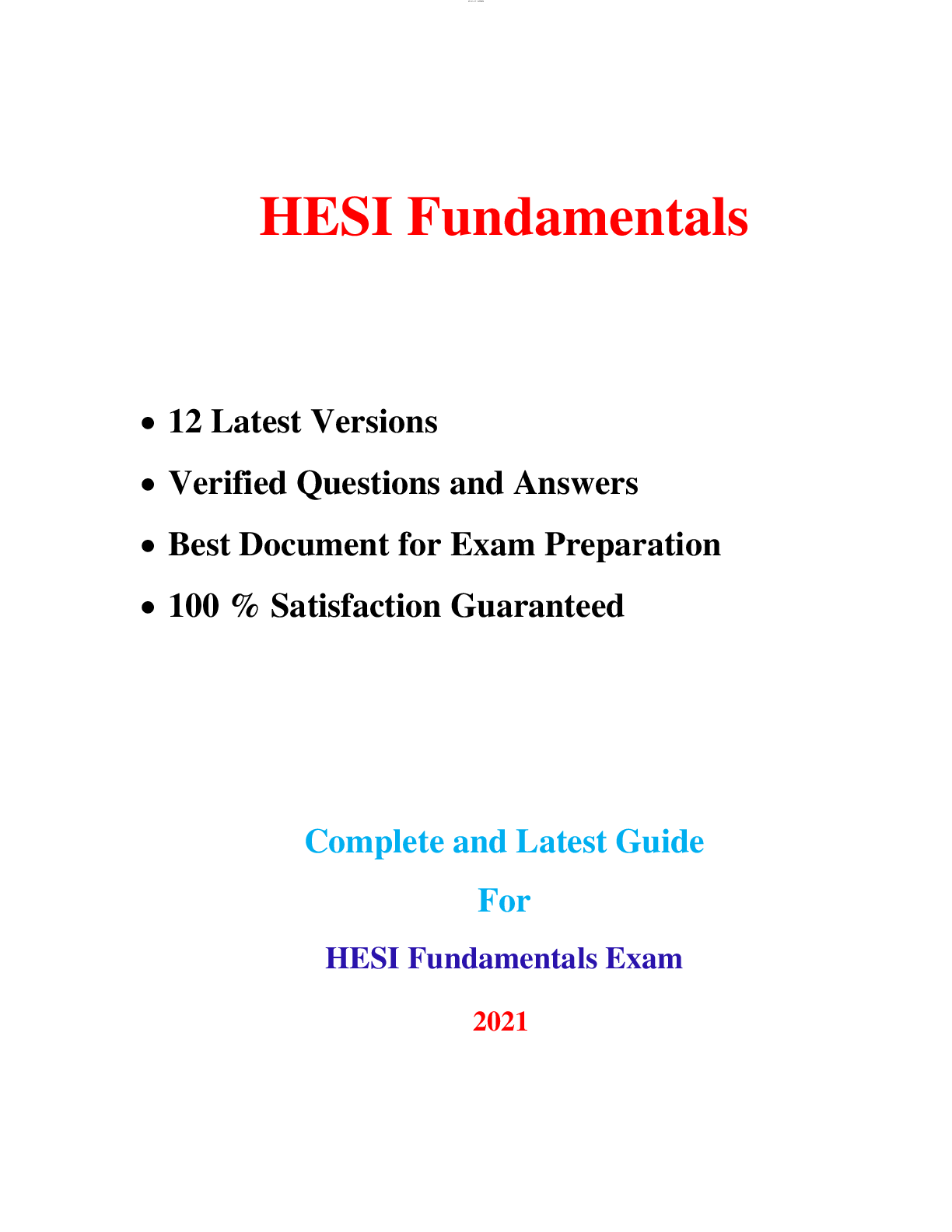
Buy this document to get the full access instantly
Instant Download Access after purchase
Add to cartInstant download
We Accept:

Reviews( 0 )
$13.00
Document information
Connected school, study & course
About the document
Uploaded On
Oct 03, 2022
Number of pages
250
Written in
Additional information
This document has been written for:
Uploaded
Oct 03, 2022
Downloads
0
Views
74

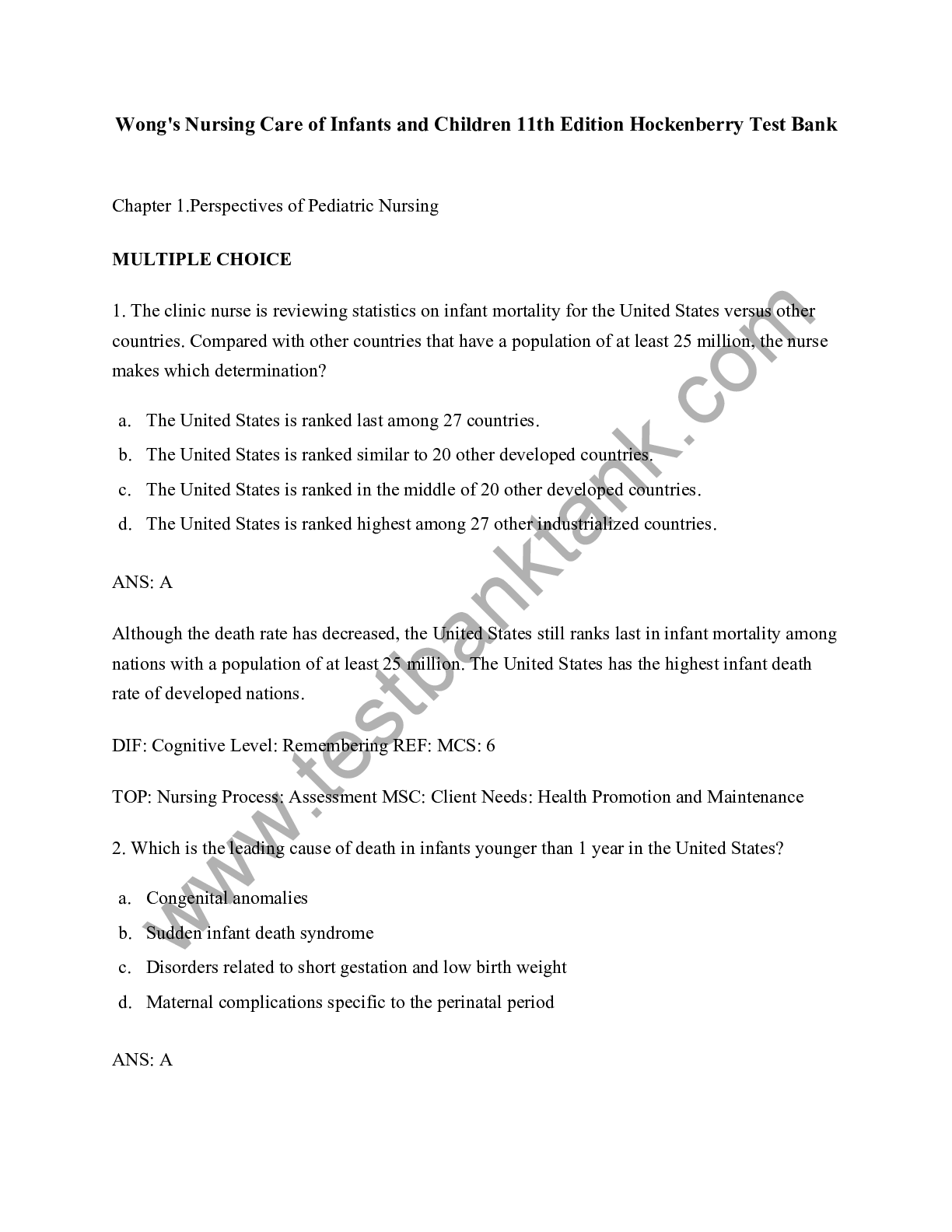




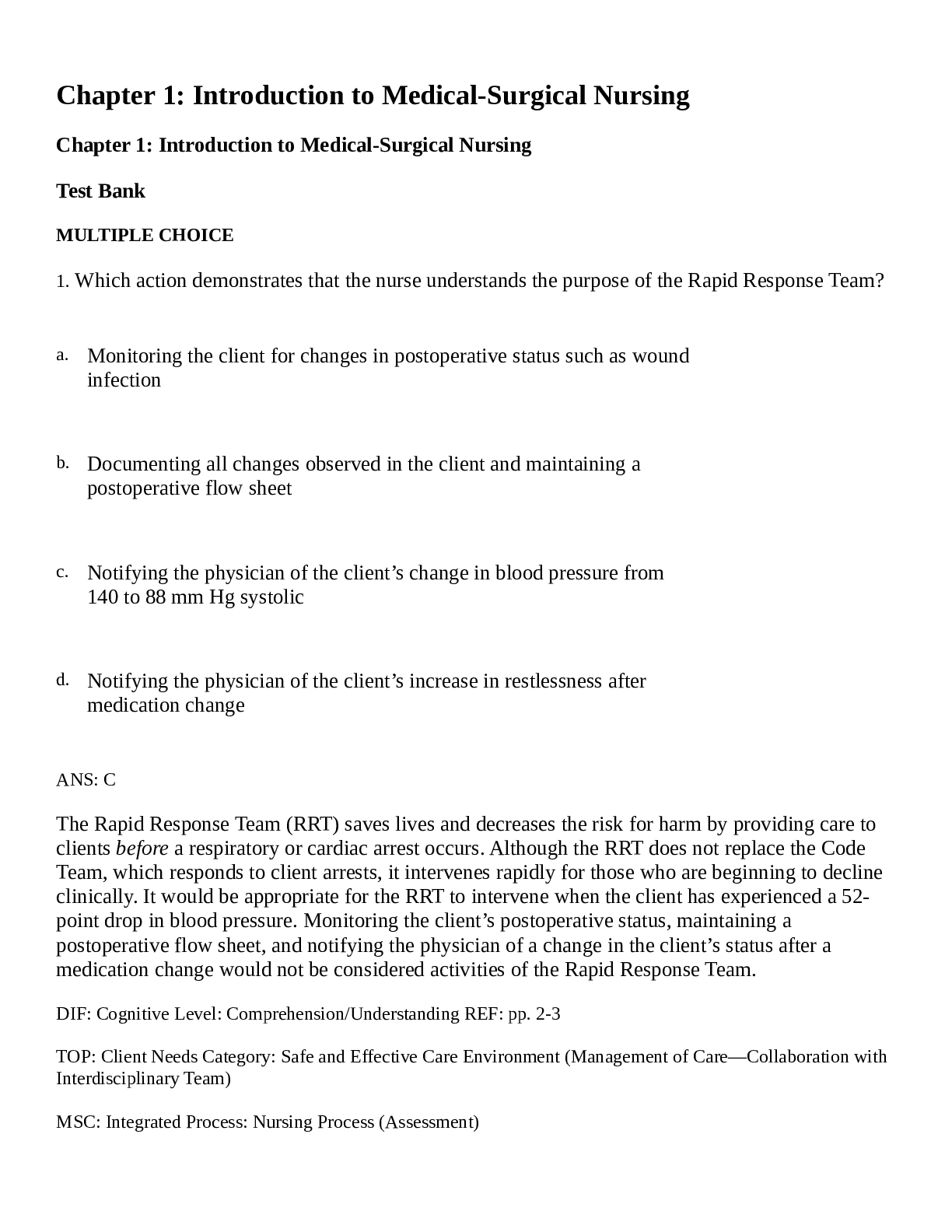


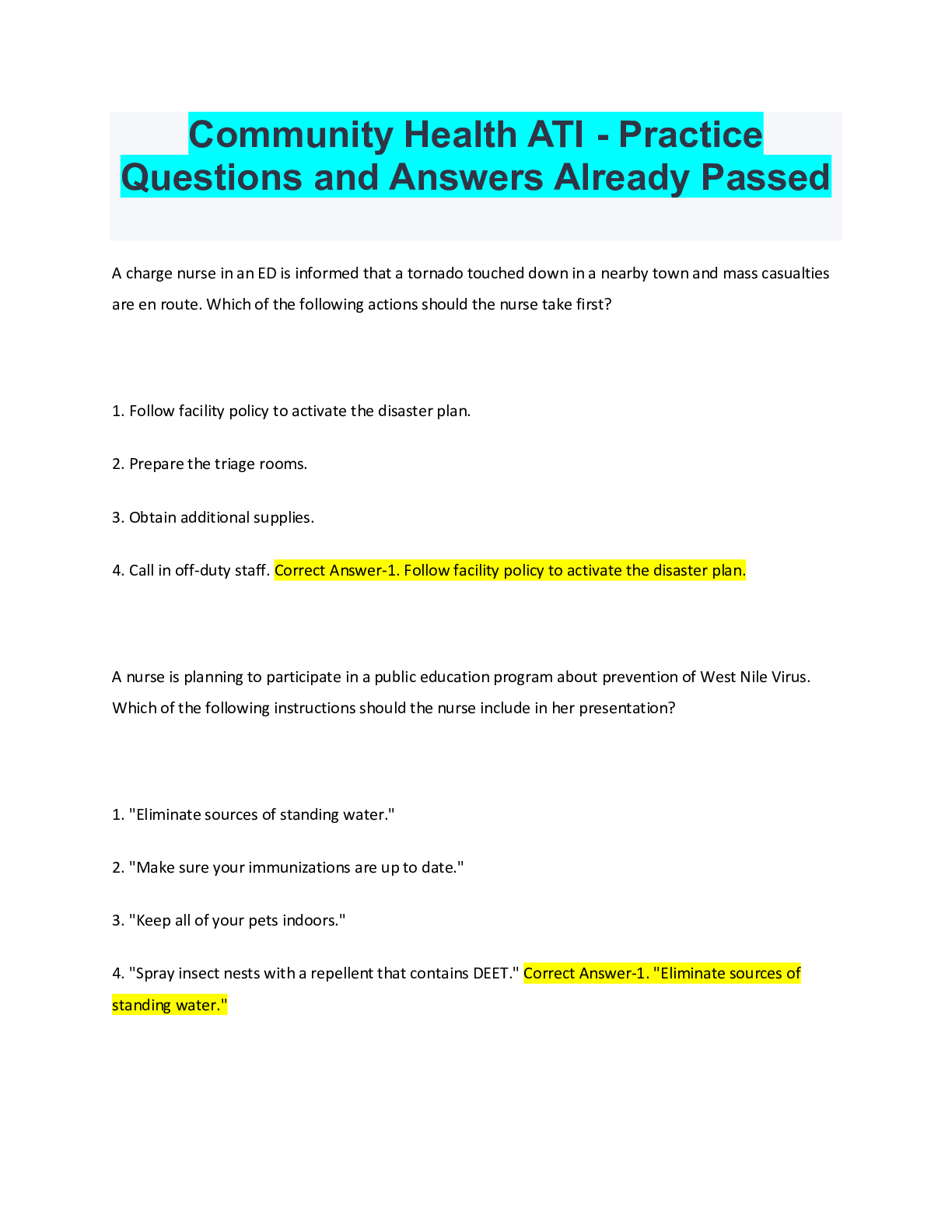
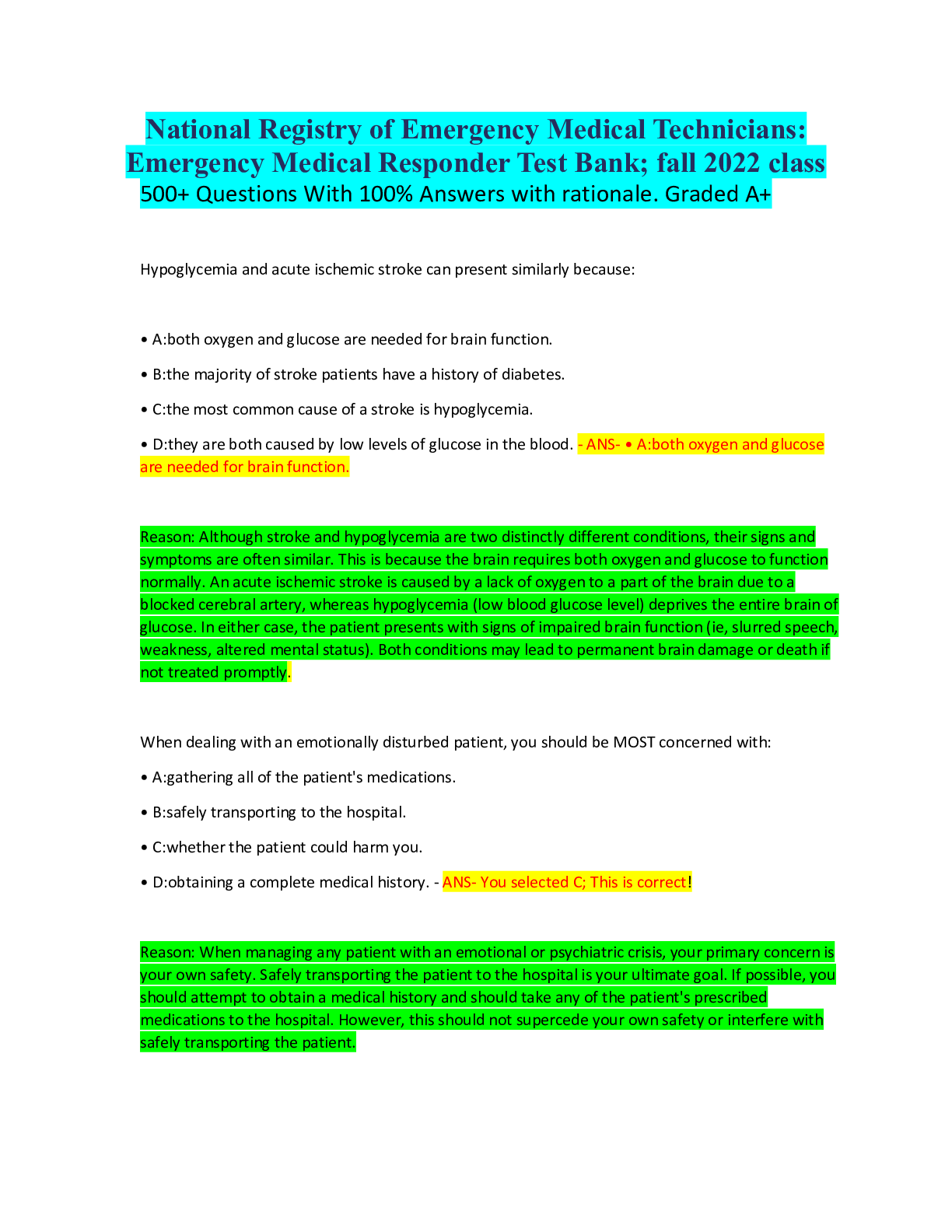

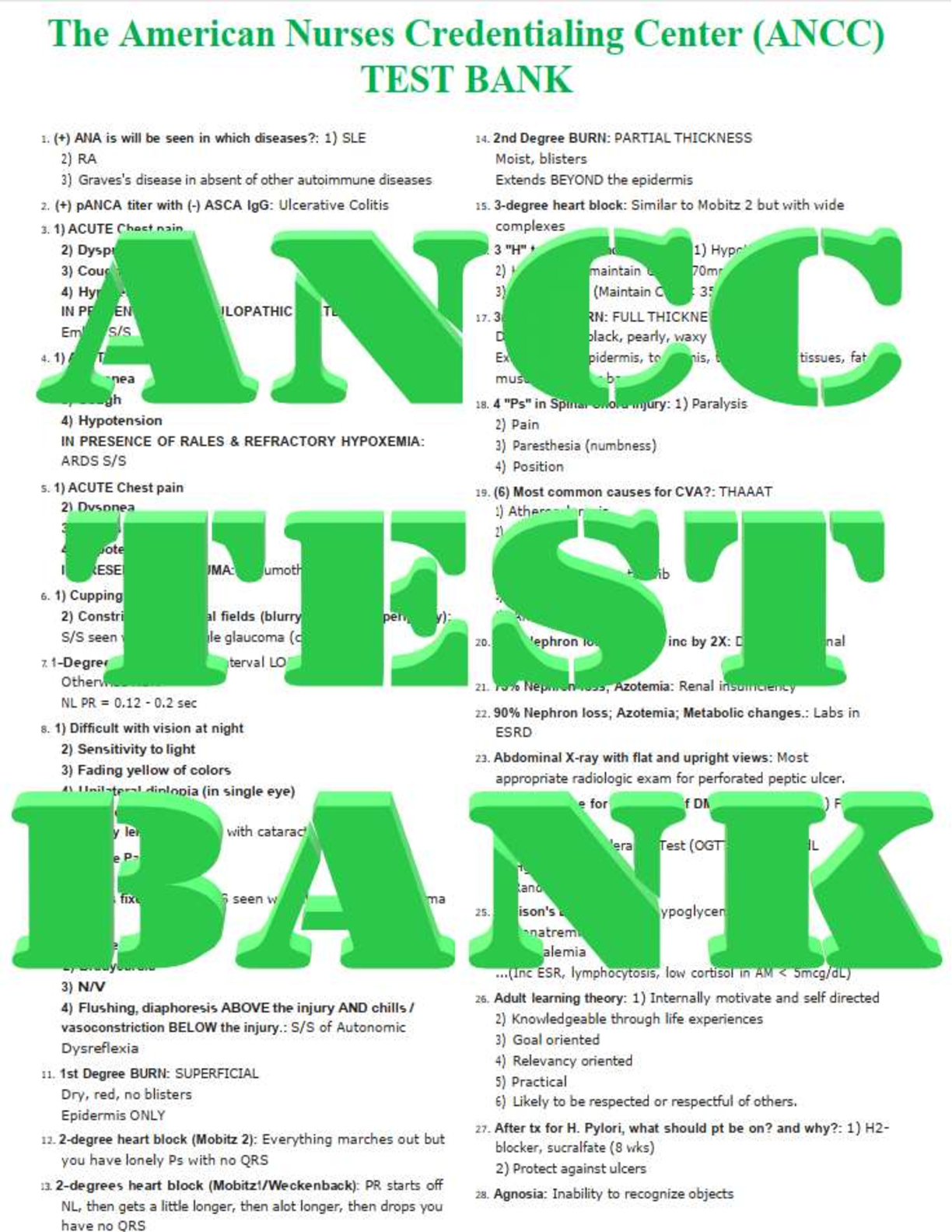
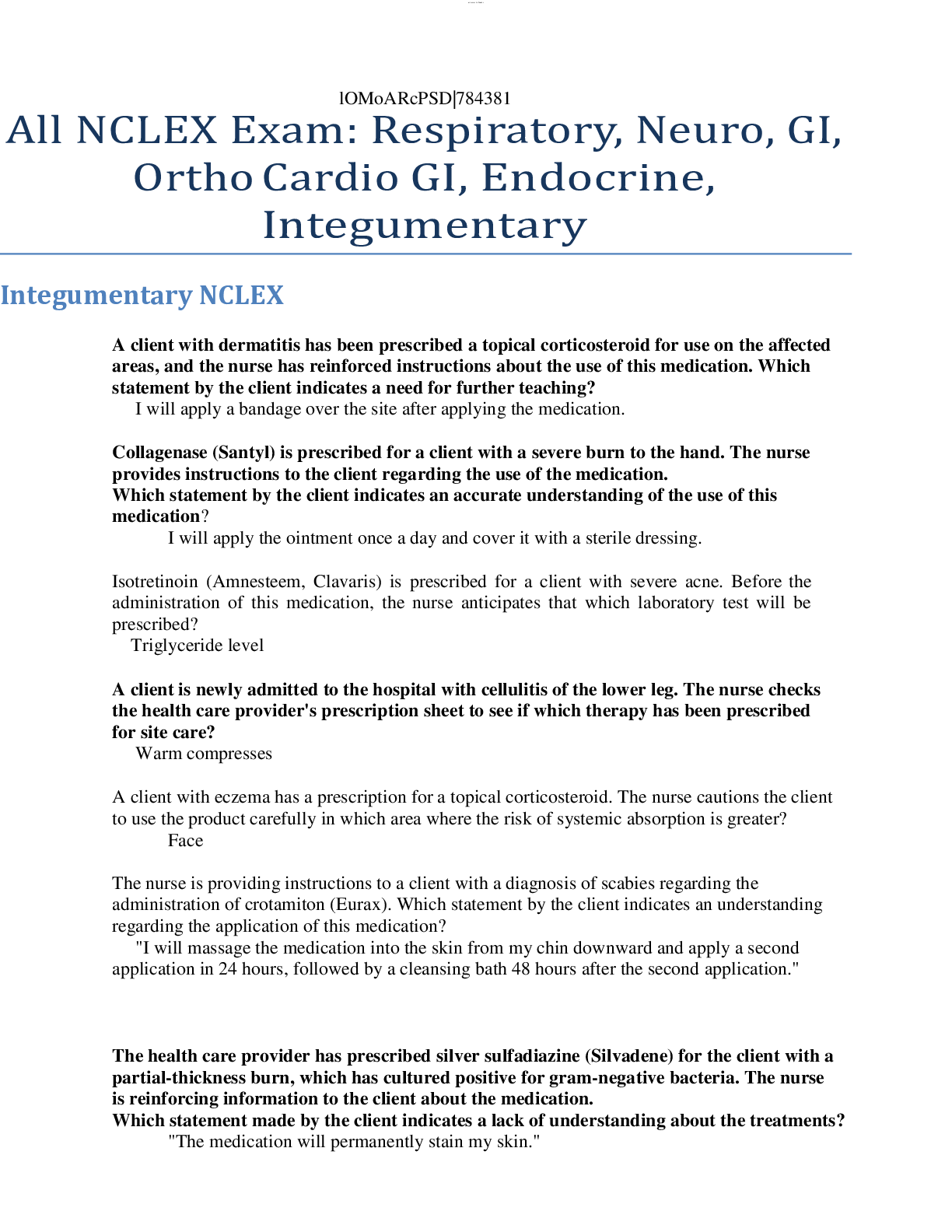

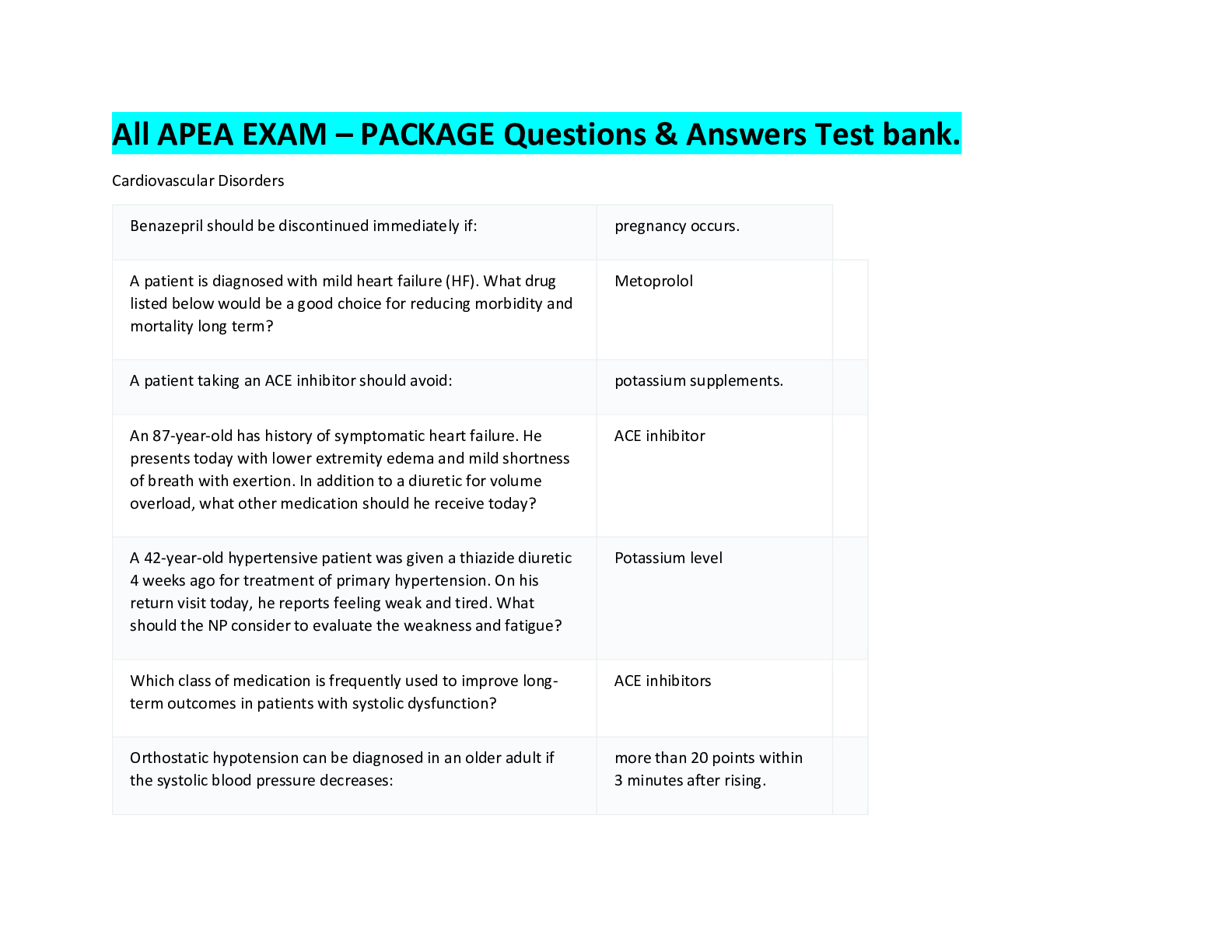


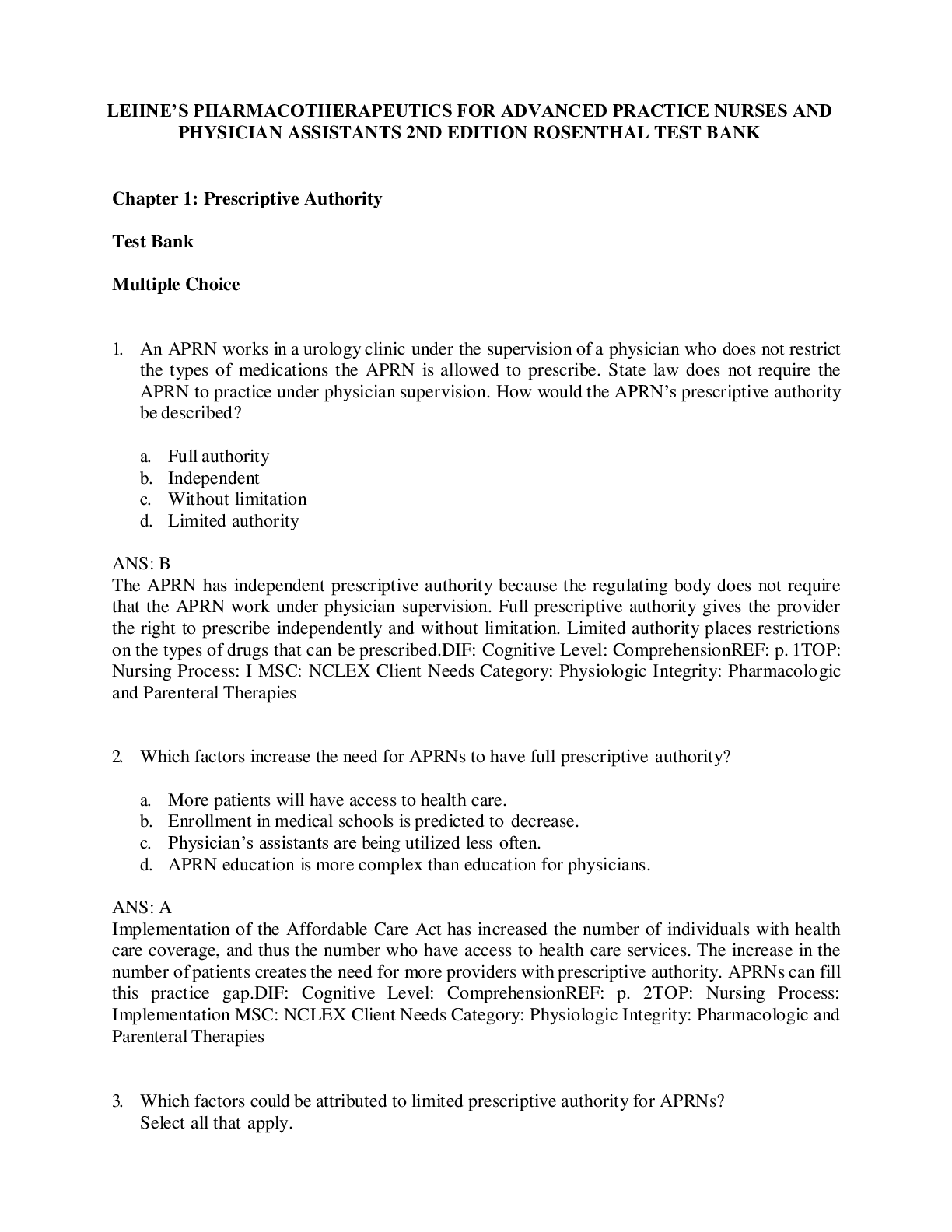
.png)

.png)


